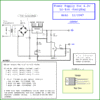My AC electrical voltage is regulated very well so I could use a 9VDC/500mA wall-wart to power an LM317 8.4V/300mA power supply.
When the current reaches about 300mA then the output of the wall-wart drops to 10.2V which is the input dropout voltage of the regulator that limits the output current.
I did not use a series output diode because my electricity is very reliable and rarely fails.
The circuit does not detect a full charge then disconnect the battery because I DOO DAT.
You know what? Many times I discharged the batteries too low. Then I let them rest and cool then I discharged them even more.
The charger never caused them to catch on fire so I am lucky.
When the current reaches about 300mA then the output of the wall-wart drops to 10.2V which is the input dropout voltage of the regulator that limits the output current.
I did not use a series output diode because my electricity is very reliable and rarely fails.
The circuit does not detect a full charge then disconnect the battery because I DOO DAT.
You know what? Many times I discharged the batteries too low. Then I let them rest and cool then I discharged them even more.
The charger never caused them to catch on fire so I am lucky.




